Table of Contents
Carbohydrates get a bad rep. In the world of nutrition, no nutrient is more demonized than carbs. And for no good reason. Not only do high-carb foods taste good, but they are also an important source of energy, fibre and other nutrients. However, every food is different and therefore it’s important to know how to make the right food choices. Today’s article will tell you which foods are the best sources of carbohydrates and how you can easily include them in your diet.
What are carbohydrates and are they necessary in the diet?
Carbohydrates are one of the three macronutrients in our diet (the other two are fats and proteins). Although many sources incorrectly claim that they cause diabetes or obesity, the truth is that we need them to live. Some cells use carbohydrates as their only source of energy. Therefore, even if the body doesn’t get them in the form of food, it will create them itself from other sources, including proteins. It can even use the protein built into the muscles as a source, which is not very healthy nor efficient. [3]
Carbohydrates should therefore make up roughly 45-60% of our total daily energy intake. With an energy intake of 2000 kcal, this represents 225-300 g of carbohydrates. This amount is recommended by the European Food Safety Authority (EFSA), but the specific amount always depends on your preferences and goals. [4]
If you are interested in what daily intake of carbohydrates is suitable for you, you can calculate it using our online calculator.

How are carbohydrates divided?
You’ve probably heard about their division into complex carbohydrates (polysaccharides) and simple carbohydrates.
- Simple carbs (which include monosaccharides and disaccharides) are typically sweet in taste. You should be more cautious with these and limit them to the maximum amount of 10% of the total daily energy intake (50 g at a reference intake of 2000 kcal).
- Polysaccharides should make up the majority of the daily carbohydrate intake. They can fill you up for a longer period of time and, thanks to slower digestion and absorption into the blood, provide you with a supply of energy slowly and gradually.
- Polysaccharides also include fibre. Although it passes through the digestive tract mostly unchanged, it still has great effects on our health. It’s needed, for example, for functional digestion and the health of the gut microbiota. It also plays an important role in inducing the feeling of satiety. Detailed information about fibre and its effect on health or weight loss can be found in the article Dietary Fibre: Why Is It Important and What Are Its Sources?
If you also want to learn more about the function of carbs, their types, metabolism or recommended intake, read the article Carbohydrates: Classification, Sources, Digestion, Functions in the Body and Optimal Intake.
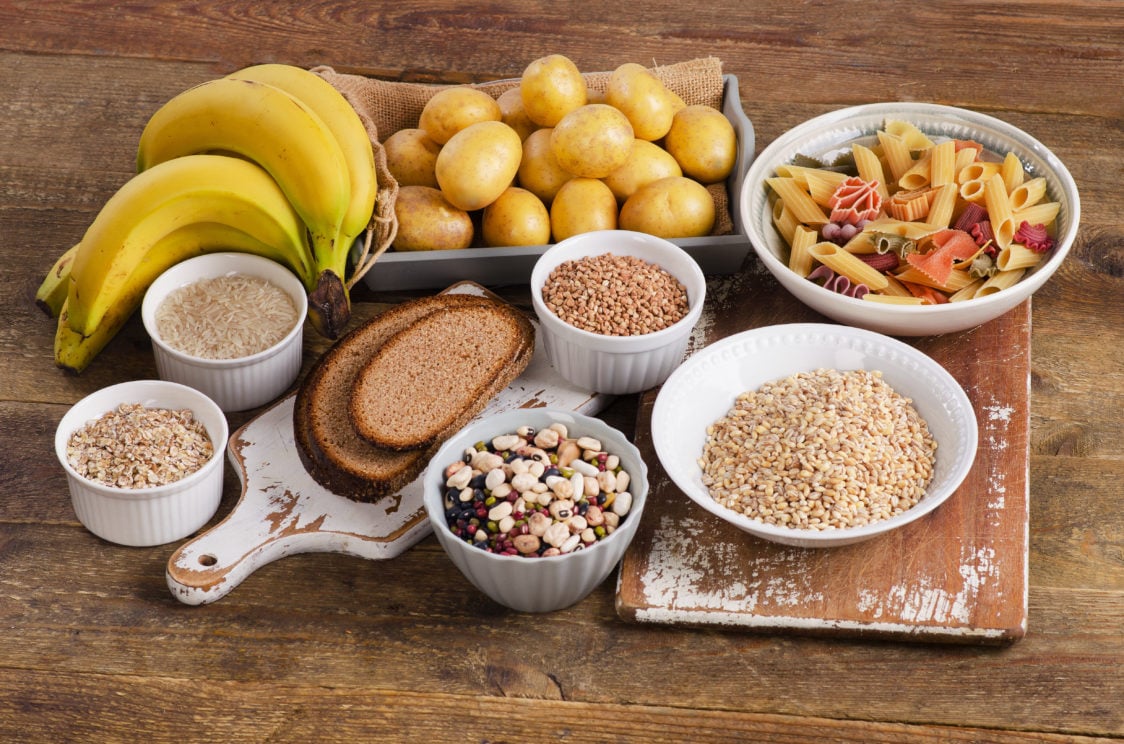
12 best sources of carbohydrates
The group of carbohydrate foods is very large and includes higher quality and lower quality sources. Your goal should be to choose healthy carbohydrates and consume foods that are rich in complex carbohydrates and contain fibre. On the other hand, you should limit the amount of simple and refined carbohydrates, which are typically highly industrially processed and lack fibre, vitamins and other bioactive compounds (these include, for example, white bread, puff pastry such as croissants, etc.).
1. Oats
Oats are among the most nutritious cereals. Oatmeal is thus a great food that fills you up, not only due to the high content of complex carbohydrates (approx. 60 g / 100 g), but also thanks to the high amount of fibre. Even people on a gluten-free diet can include oats in their diet. Oats contain a different type of gluten than other cereals, which most people with gluten intolerance do not mind. However, in the case of a strict gluten-free diet with celiac disease or gluten allergy, it is advisable to buy products explicitly labelled as “gluten-free oats“. [22]

There are about 11 g of fibre in 100 g of oats, which is about a third of the daily recommended intake for an adult. An oatmeal from 50 g of oats will supply you with roughly 5.5 g of fibre, which is roughly a fifth of the recommended daily intake.
One of the types of fibre found in oats is also very interesting. It’s called beta-glucan, which can help, for example, with lowering the level of cholesterol or blood sugar. In addition, it is a soluble fibre that acts as a probiotic. This means that it functions as food for beneficial gut bacteria and can help improve your microbiome. [11,19]
What other nutrients are in oats?
To make matters even better, oats also boast a high amount of protein. They can have up to 14 g of protein / 100 g. In other cereals, this figure is only around 10 g / 100 g. They are not far behind in the proportion of fat either, because they are rich in unsaturated fatty acids (they contain an average of 2.2 g/100 g). These include oleic acid or linoleic acid (omega-6). These fatty acids benefit your heart and blood vessels.
In addition to protein, healthy fat and fibre, oats also contain folic acid (vitamin B9), which is necessary for the proper development of the body. They are also rich in B vitamins and vitamin E, which acts as an antioxidant in the body.
Approximately how much energy and nutrients do oats contain?
| Energy Value | 357 kcal / 1499 kJ |
| Carbohydrates | 55.7 g |
| Protein | 16.9 g |
| Fat | 6.9 g |
| Fibre | 10.6 g |
How to include oats in your diet?
- Prepare tasty oatmeal for breakfast or any other meal. Try, for example, cocoa and coffee flavour.
- If you are tired of eating cooked porridge all the time, you can try baking it for a change.
- You can also try some savoury oatmeal, for example with a poached egg.
- Oats can also serve as a part of a cake. Try these chocolate cupcakes, for example.
- Oats are also suitable for thickening soups or sauces. You can also add them to the batter or dough when you bake something sweet or savoury.
If, by any chance, all this information about oats wasn’t enough for you, read our article dedicated only to them: Oats: What Nutrients They Contain and Why Include Them in Your Diet.
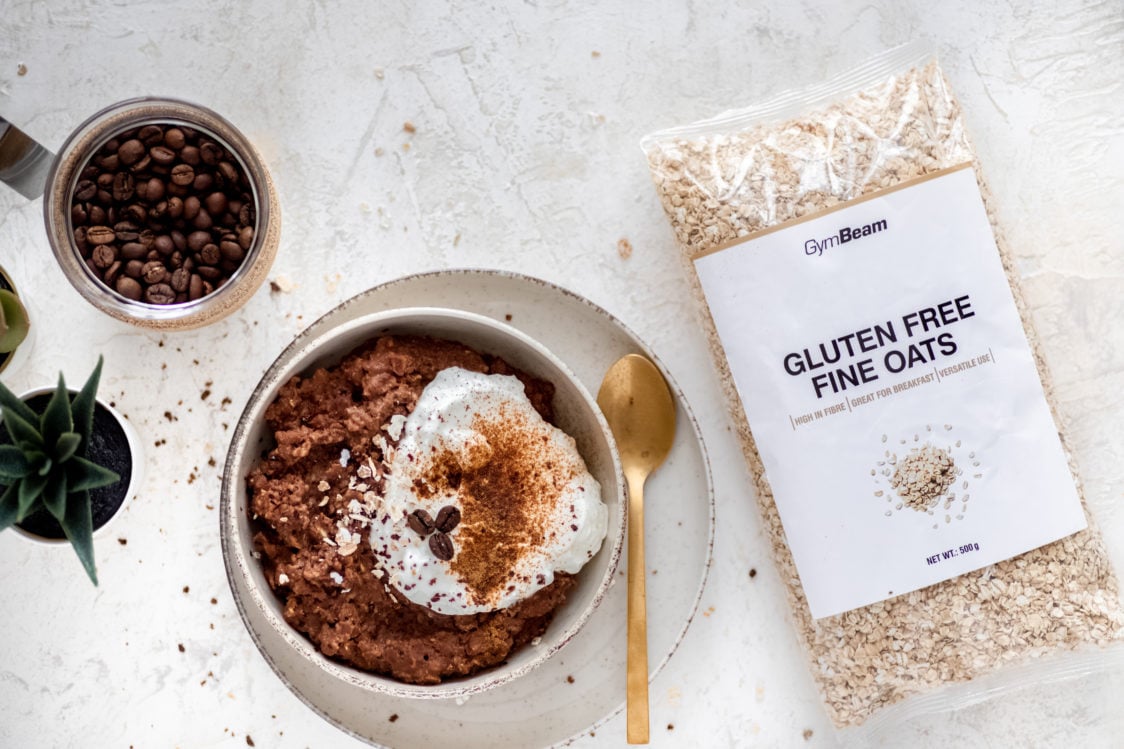
2. Quinoa
There are still many people who have never tried quinoa. And they are missing out! This plant, originally from the South American Andes, is basically a nutritional bomb. And it’s also naturally gluten-free. People with celiac disease or gluten allergy can thus include it in their diet. It is classified among pseudocereals, which, unlike some other cereals, don’t contain gluten.
You can spice up your menu with several types of quinoa, namely white, black or red.
The main component of quinoa is polysaccharides, which make up about 60% of its content. The amount of fibre in them is comparable to cereals. It contains an average of 7 g fibre / 100 g.
What other nutrients does quinoa contain?
Quinoa excels thanks to its high-quality protein content. And that’s because, unlike most plant sources, it has a more optimal ratio of essential amino acids (those that need to be consumed in food). Plant foods contain some essential amino acids in insufficient amounts, and are therefore generally considered to be incomplete sources of protein. However, the protein composition of quinoa is more favourable compared to other plant sources. It contains, for example, a decent amount of methionine, which cereals generally lack. [18]
Some vitamins contained in quinoa are also worth mentioning, for example, the content of folic acid and vitamin E. Quinoa is also rich in niacin (vitamin B3), which is needed for the proper functioning of the nervous system and skin health. From beta-carotene, which is also found in quinoa, the body produces vitamin A, which is necessary for the health of the eyes and the immune system.[18,19]
Approximately how much energy and nutrients does quinoa contain?
| Energy Value | 352 kcal / 1480 kJ |
| Carbohydrates | 57 g |
| Protein | 14 g |
| Fat | 6 g |
| Fibre | 7 g |
How to include quinoa in your diet?
- Before you cook quinoa, rinse it under running water using a fine-mesh strainer. Then you can get cooking.
- Turn it into a porridge, for example this one with poppy seeds and apples.
- Quinoa is also suitable as an addition to soups.
- Replace classic side dishes such as rice or potatoes with quinoa and prepare it, for example, with some Asian style chicken.
You can learn more about quinoa in our article Quinoa – A Gluten-Free Cereal and a Superfood Rich in Protein, Fibre and Vitamins.
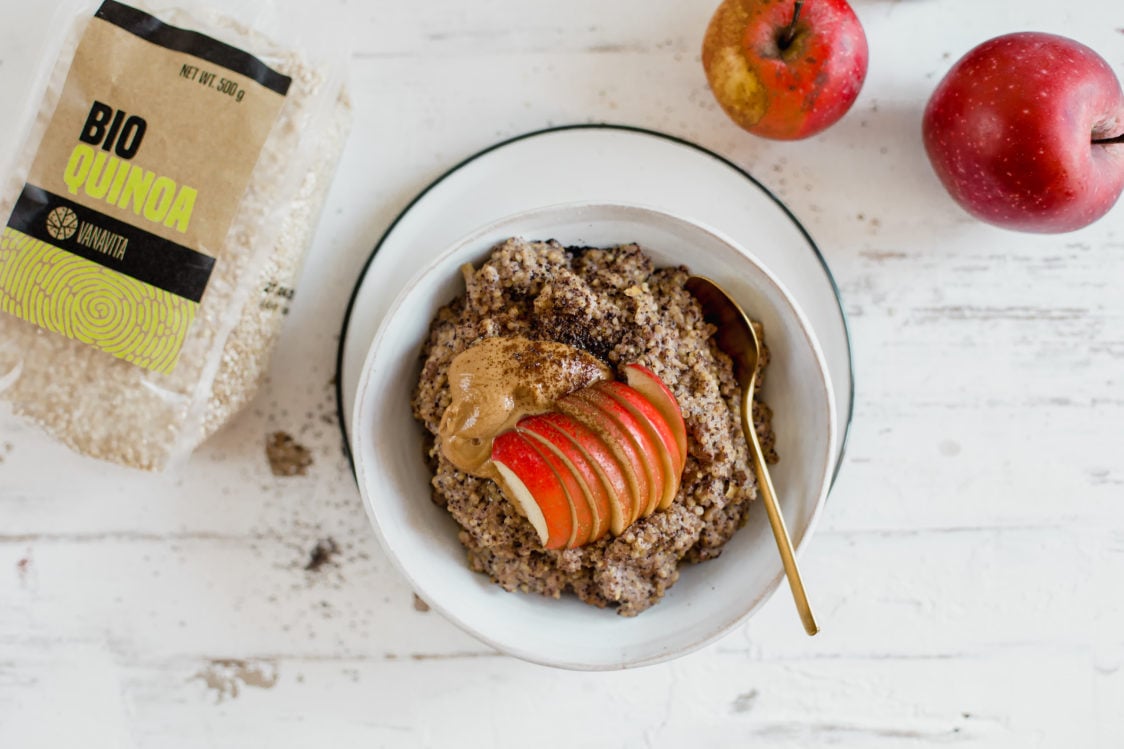
3. Buckwheat
Buckwheat is typical for its slightly nutty taste. If you didn’t like it the first time you’ve tried it, give it another chance. It’s quite possible that you will actually fall in love with its specific taste. And if that happens, you will always have a versatile food at hand, which can be used not only as a side dish to meat, but also as a raw ingredient for sweet dishes. You can also buy buckwheat in the form of flakes or instant porridge.
Like quinoa, buckwheat also belongs to pseudocereals, so everyone on a gluten-free diet can appreciate it. Thanks to the content of resistant starch, which is one of the types of soluble fibre, it can also contribute to a better composition of the gut microbiota or help reduce the absorption of cholesterol into the blood. [9]
What other nutrients does buckwheat contain?
You surely must have heard about the content of rutin (vitamin P) in buckwheat. It is one of its main bioactive compounds, which has antioxidant effects. It thus helps to destroy free radicals, which can contribute to the emergence of various diseases in the body, such as cancer-related, neurological or, for example, cardiovascular problems. Rutin also has proven effects on the health of vascular walls. This is also why it is recommended, for example, to people who suffer with varicose veins. 100 g of buckwheat contains approximately 5 mg of rutin. Effects of higher doses, up to around 500 mg, are also being observed by studies. You can take this amount, for example, in the form of a nutritional supplement. [5,12,19]
How much energy and nutrients does buckwheat contain?
| Energy Value | 353 kcal/ 1478 kJ |
| Carbohydrates | 62 g |
| Protein | 13 g |
| Fat | 3.5 g |
| Fibre | 10 g |
How to include buckwheat in your diet?
- Rinse the buckwheat with running water before preparation. You can then choose whether to boil it or cover it with hot water and leave it to cook under the lid.
- You can use it as a replacement to other side dishes and use it as a side to your meaty lunch. You can also use it to replace rice in risottos.
- Buckwheat can be used as the basis of sweet porridge, or as an alternative to pasta you’d normally add to a soup.
- You can also try, for example, making pancakes from it.
You might be interested in these products:
4. Millet
Millet is a raw ingredient that is created by peeling millet grains. It’s not very common in the developed world, which is quite a shame, because it has a neutral taste and it can be used in many recipes. Most people should include it in their diet, as this cereal has many health benefits. One of them might be, for example, its antioxidant effects or its effect on blood sugar levels. These benefits can also be appreciated by people with celiac disease or gluten allergy, because millet is naturally gluten-free. [7]
There are several types of millet, and each differs slightly in its nutrient content. However, the proportion of polysaccharides generally ranges from 63 to 70 g/100 g. The amount of fibre is also quite high, roughly 9 g / 100 g. Thanks to the content of soluble fibre, it can help induce a greater feeling of satiety and thus help, for example, with weight loss.
What other nutrients does millet contain?
Millet contains an average of 12 g of protein / 100 g, which is slightly higher compared to most cereals (the protein content is usually around 10 g / 100 g). It also has a high content of phosphorus, calcium and zinc. All of these minerals are needed for healthy bones. This cereal also contains various bioactive compounds, such as phenolic compounds or ferulic acid, which have antioxidant effects. [7,19]
How much energy and nutrients does millet contain?
| Energy Value | 364 kcal / 1529 kcal |
| Carbohydrates | 66 g |
| Protein | 12 g |
| Fat | 4 g |
| Fibre | 9 g |
How to include wheat in your diet?
- You can use it similarly to all the other foods mentioned so far. Its advantage is that it goes well with both sweet and savoury dishes.
- You can prepare sweet or savoury porridge.
- It can be used similarly to rice in risotto or rice pudding.

5. Potatoes
Is there a more underrated carbohydrate food than potatoes? Many people still think that they should be eliminated from the diet. For some reason, there is an understanding that potatoes are a carb bomb with a lot of energy. But it is the exact opposite of the truth.
Potatoes are vegetables and on average have only 16 g of carbohydrates / 100 g. Compared to rice, for example, it is only a fifth of its carbohydrate content. In practice, this means that 100 g of white rice (raw) has the same amount of carbohydrates as 490 g of potatoes (raw). Such a low-carb content makes them a great helper for weight loss.
Unlike other carbohydrate-rich foods, however, they have a slightly higher glycemic index (GI). This means that they raise blood sugar (glycemia) more quickly after a meal. However, you don’t have to worry about it, because the low carbohydrate content in potatoes (the so-called low glycemic load) will reduce this effect. In addition, the GI of potatoes can be reduced by adding other nutrients, namely protein, fat or fibre, for example in the form of other vegetables. The method of preparation also plays its role (e.g. deep-fried chips have a higher GI than boiled potatoes). In the end, potatoes, as part of a complete meal, can be enjoyed even by people with diabetes or impaired glucose tolerance, who should purposefully keep their blood sugar level under control. [1]
What other nutrients do potatoes contain?
Potatoes are a good source of potassium and vitamin C. Vitamin C is needed not only for the proper functioning of the immune system, healthy bones, cartilage and skin. Potassium is important for the correct transmission of nerve signals or maintaining a normal blood pressure level. [19]
How much energy and nutrients do potatoes contain?
| Energy Value | 76 kcal / 319 kcal |
| Carbohydrates | 16 g |
| Protein | 2 g |
| Fat | 0.01 g |
| Fibre | 2 g |
How to include potatoes in your diet?
- You don’t have to get stuck on basic boiled potatoes with some meat or mashed potatoes with fish. You can turn potatoes into something special, for example by adding an interesting marinade and pushing the dish to another level.
- You can bake potatoes, use them to thicken soup or mash them into various patties or savoury cakes.
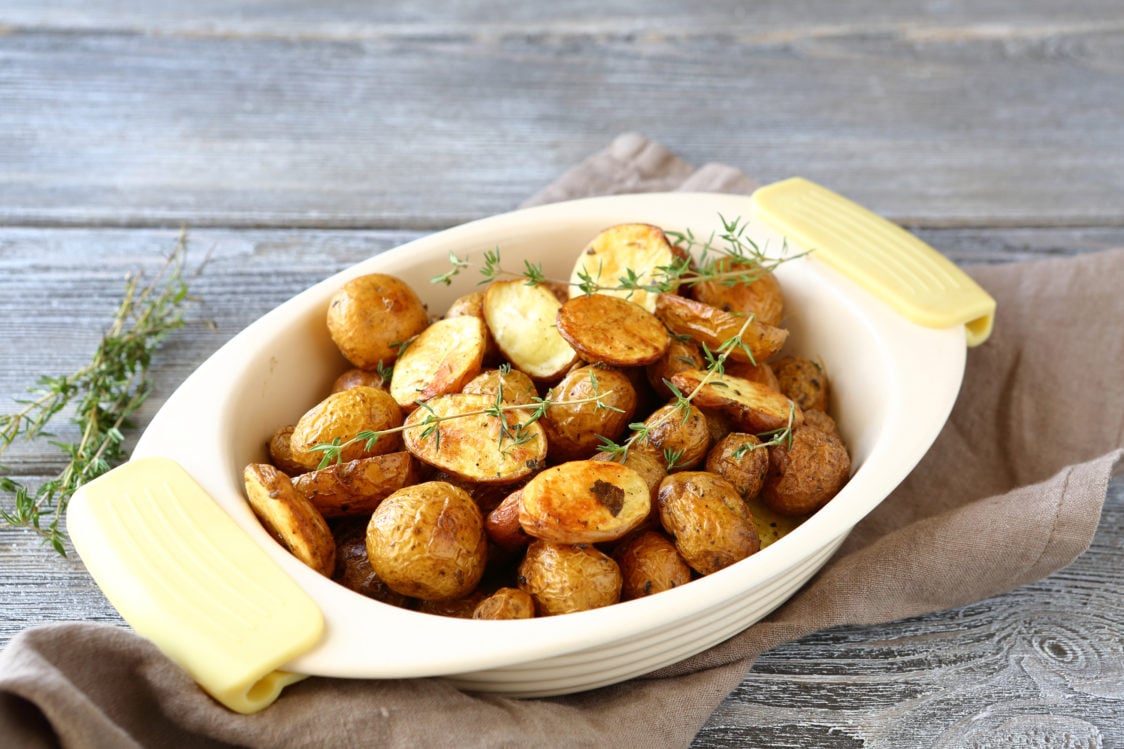
6. Sweet potatoes
Those who are tired of eating classic potatoes all the time can diversify their menu with colourful sweet potatoes. And not only the most popular orange ones. There are also yellow, purple or pink varieties. Just like classic potatoes, sweet potatoes are considered vegetables, so their energy value is similarly low. They have around 80 kcal / 100 g. The content of high-quality polysaccharides is approx. 17 g / 100 g.
What other nutrients do sweet potatoes contain?
Vegetables are not typically high in protein, and the same is true for sweet potatoes. However, they contain one very specific type of protein. The so-called sporamin is a protein that helps sweet potatoes to “heal” after mechanical damage and have an antioxidant effect on people. At the same time, like other colourful vegetables, sweet potatoes are also rich in beta-carotene. It not only has great antioxidant effects, but it also produces vitamin A in the body, which is important for supporting the immune system. Sweet potatoes are also a source of vitamin C, potassium and iron. [10,14,19]
How much energy and nutrients do sweet potatoes contain?
| Energy Value | 81 kcal / 340 kJ |
| Carbohydrates | 17 g |
| Protein | 1.6 g |
| Fat | 0.1 g |
| Fibre | 3 g |
How to include sweet potatoes in your diet?
- You can try cutting them into pieces with other types of vegetables and turning them into baked chips.
- Use them in the same way as classic potatoes – as a side dish, in soups, etc.
- Keep them sweet and turn them into a delicious chocolate cream.

7. Rice
Did your brain automatically imagine the short-grain white rice you usually have as a side dish to your chicken? It’s very popular, but you don’t have to get stuck with it. You can treat yourself to any of the countless types of rice available.
In addition to milled white rice, there are also the following types:
- Natural rice can be found in shops under the name brown rice. Unlike the milled white one, it has retained the upper shells of the grain and thus retains a lot of nutrients.
- Parboiled rice is processed using a special method, where the nutrients from the grain shell are passed into its interior. After removing the shell, it then retains more nutrients than classic white rice.
- If you’ve heard about arborio rice, it must have been in relation to Italian cuisine, where it is used in risotto. It is also suitable, for example, in rice pudding.
- Red rice has a slightly nutty taste and originates from the Himalayan mountains.
- Jasmine rice has a glutinous consistency and is often used in Asian cuisine, commonly for dishes served with some sauce.
- Basmati rice is typical for its distinctive taste and quick preparation and is mainly used in Indian cuisine.
- Wild rice (also called Indian rice) comes from North America and is one of the most nutritious types out there.
All types of rice are mainly a source of polysaccharides, as they contain roughly 70-80 g/100 g of them. However, they differ from each other in the proportion of other substances. The big difference is, for example, in the amount of fibre. White rice has less than 2 g/100 g of fibre because it was stripped of its fibre-filled grain shells. In the case of whole-grain variants that have not been stripped of their shells (e.g. brown rice or wild rice), its content is higher than 3.5 g / 100 g and can reach up to 6 g / 100 g.
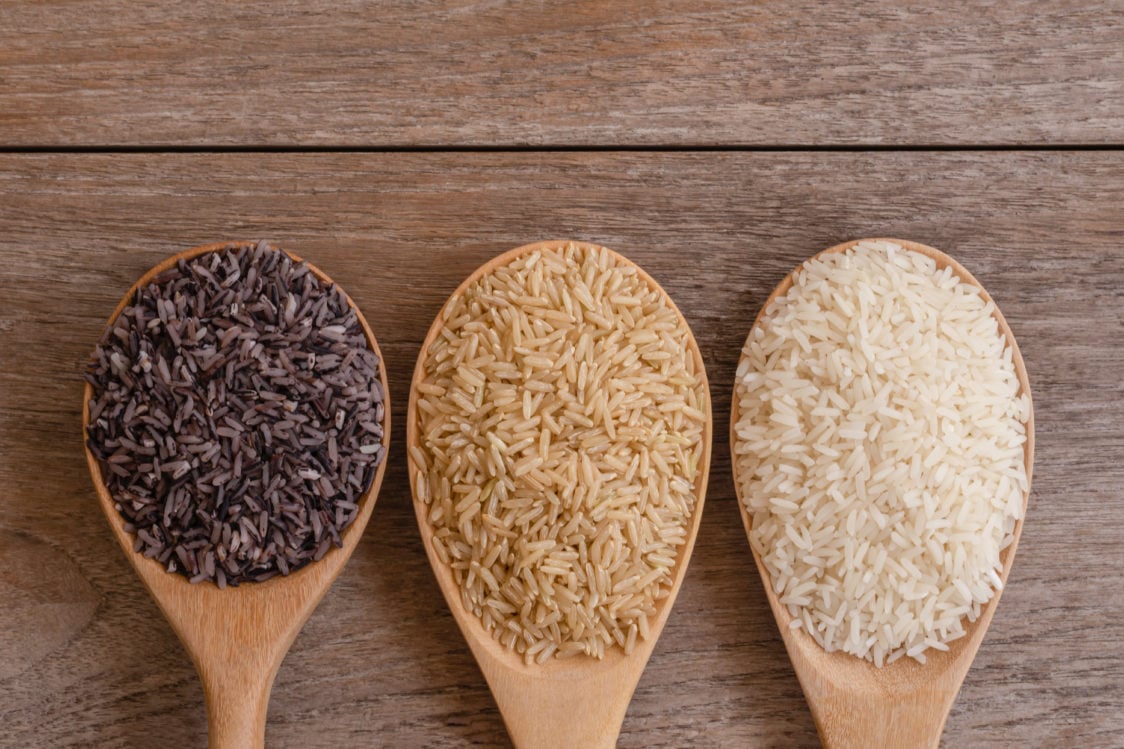
What other nutrients does rice contain?
White rice naturally contains a small amount of vitamins, minerals and other bioactive compounds. However, brown rice and other whole grain variants are a good source of folic acid and other B vitamins. One of them is thiamine (vitamin B1), which is needed for the proper functioning of the heart and nervous system. [19]
Approximately how much energy and nutrients does rice contain?
| White Rice | Brown Rice | Basmati | Basmati Natural | Wild Rice | Parboiled Rice | |
|---|---|---|---|---|---|---|
| Energy Value | 356 kcal / 1495 kJ | 352 kcal / 1478 kJ | 350 kcal / 1470 kJ | 362 kcal / 1520 kJ | 357 kcal / 1500 kcal | 359 kcal / 1508 kJ |
| Carbohydrates | 79 g | 73 g | 78 g | 76 g | 69 g | 79 g |
| Protein | 7 g | 7.5 g | 7.4 g | 9 g | 15 g | 7.5 g |
| Fat | 1 g | 2.6 g | 0.6 g | 2 g | 1 g | 1 g |
| Fibre | 1.7 g | 3.5 g | 1.6 g | 2.2 g | 6 g | 1.8 g |
How to include rice in your diet?
- The easiest way is to use it as we all know it, as a classic accompaniment to meat. If you switch the type of rice every now and then, even this simple side dish can stay fresh and interesting.
- However, if you want to spice it up a little, you can prepare it as part of a meal inspired by Indian cuisine.
- Rice can also be made sweet, for example as homemade rice pudding.

8. Wholemeal bread
That’s right, baked goods also belong to a healthy diet. They are a source of complex carbs and fibre, like other cereal products, and can have the same positive effect on the body. It’s extremely handy for fighting off hunger and inducing a feeling of satiety. An egg omelet with rye bread will fill you up more and for a longer period of time than an omelet without or with white bread. However, if you want to get all the benefits that bread can offer, you need to know how to choose the right one.
Apart from polysaccharides and a small amount of protein and fat, bread made from white wheat flour doesn’t provide you with any other important substances, just like other sources of refined carbohydrates. However, whole grain bread also contains fibre, minerals, vitamins and other bioactive compounds. These compounds are mainly found in the shells of cereal grains, which are removed during the production of white wheat flour, but they remain in whole-grain flour. That is why it is advantageous to choose whole grains.

How to choose the right bread?
- Look for baked goods with “wholemeal” on the label.
- Types called “cereal”, “multi-grain”, “seven-grain”, etc. are composed mainly of white wheat flour, while the darker colour is added later by colourants, for example caramel. An example of such bread is the popular multi-grain or multi-seed kaiser roll.
- Rye bread is also a very good option. If straight rye bread is too much for you, rye-wheat one could be a good compromise (since rye is in the first place in the name, its proportion in bread should be greater than that of wheat).
What other nutrients does wholemeal bread contain?
Like other wholemeal products, wholemeal bread is rich in B vitamins, magnesium, zinc and other nutrients. [6]
How much energy and nutrients does bread contain?
| White Wheat Flour Bread (100g) | Wholemeal Bread (100g) | Rye Bread (100 g) | |
|---|---|---|---|
| Energy Value | 253 kcal / 1063 kJ | 242 kcal / 1014 kJ | 241 kcal / 1012 kJ |
| Carbohydrates | 46 g | 37 g | 42 g |
| Protein | 9 g | 12.5 g | 8.5 g |
| Fat | 3 g | 3.5 g | 3 g |
| Fibre | 3 g | 6 g | 6 g |
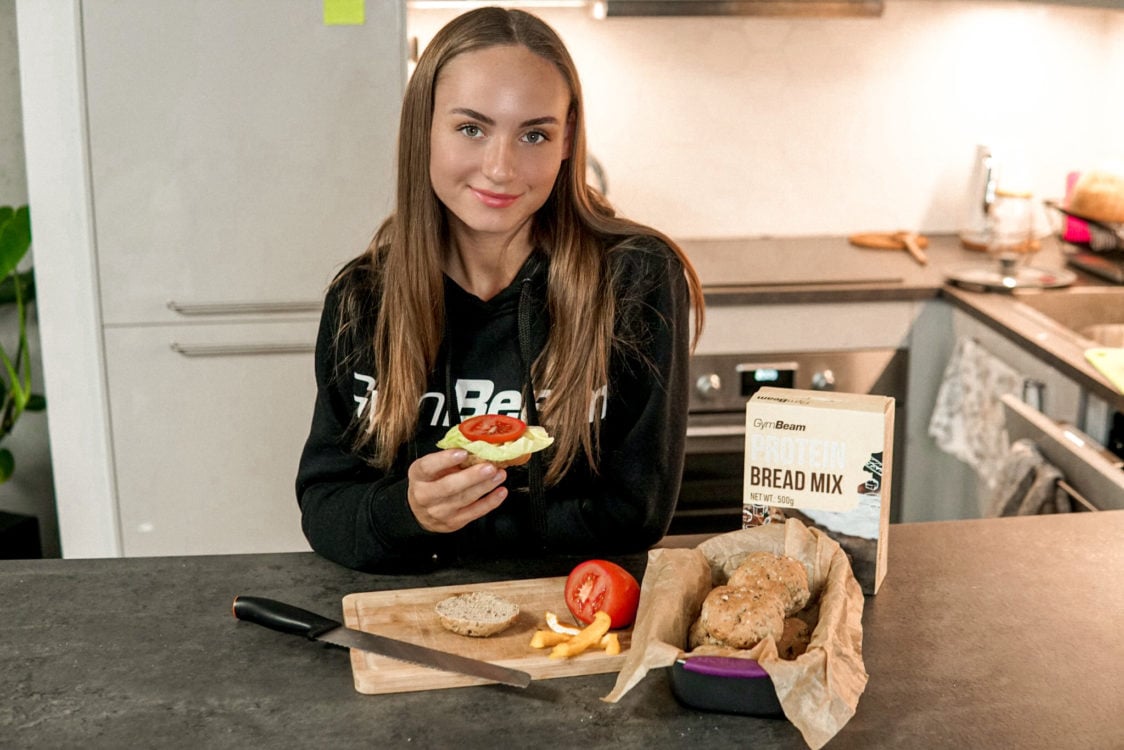
9. Pasta, couscous, bulgur
Similar to bread or rice, here you can also choose between a classic type made from white wheat flour or a whole grain alternative. They all can provide you with a similar amount of carbohydrates, roughly 65-75 g / 100 g, but they differ in the content of fibre and micronutrients.
- Pasta made from white wheat flour has about 3 g of fibre / 100 g, while wholewheat pasta has up to three times as much, roughly 9 g / 100 g.
- Pasta made from pseudocereals or legumes is also something worth trying out. They differ not only in fibre content, but also in vitamins and other bioactive compounds.
- Couscous is also available in the classic white and whole-grain versions. The whole-grain one is more nutritious for the reasons already mentioned, and the advantage is that it tastes very similar to the regular one.
- Bulgur is made by grinding the whole-wheat groats. Since no part of the grain is removed, this food retains all its minerals and vitamins, as well as fibre.
How much energy and nutrients do these foods contain?
Classic Egg-Free Wheat Pasta (100g) | Wholewheat Pasta (100g) | Bulgur (100 g) | Whole Grain Couscous (100 g) | ||
|---|---|---|---|---|---|
| Energy Value | 358 kcal / 1504 kJ | 356 kcal / 1495 kJ | 338 kcal / 1420 kJ | 359 kcal / 1508 kJ | 333 kcal / 1399 kJ |
| Carbohydrates | 71.5 g | 64 g | 63 g | 73 g | 65 g |
| Protein | 13 g | 14 g | 12 g | 13 g | 12 g |
| Fat | 1.5 g | 3 g | 1.3 g | 0.6 g | 1 g |
| Fibre | 3 g | 9 g | 13 g | 5 g | 8 g |
How to include these foods in your diet?
- You can use all of them as you would normally – as a side dish to the main meal. Try, for example, creamy chicken spinach pasta.
- Try baking them, for example.
- They can also be made sweet, for example like this baked couscous pudding.
If you want to diversify your menu with different types of pasta, read our article How to Replace Regular Wheat Pasta?
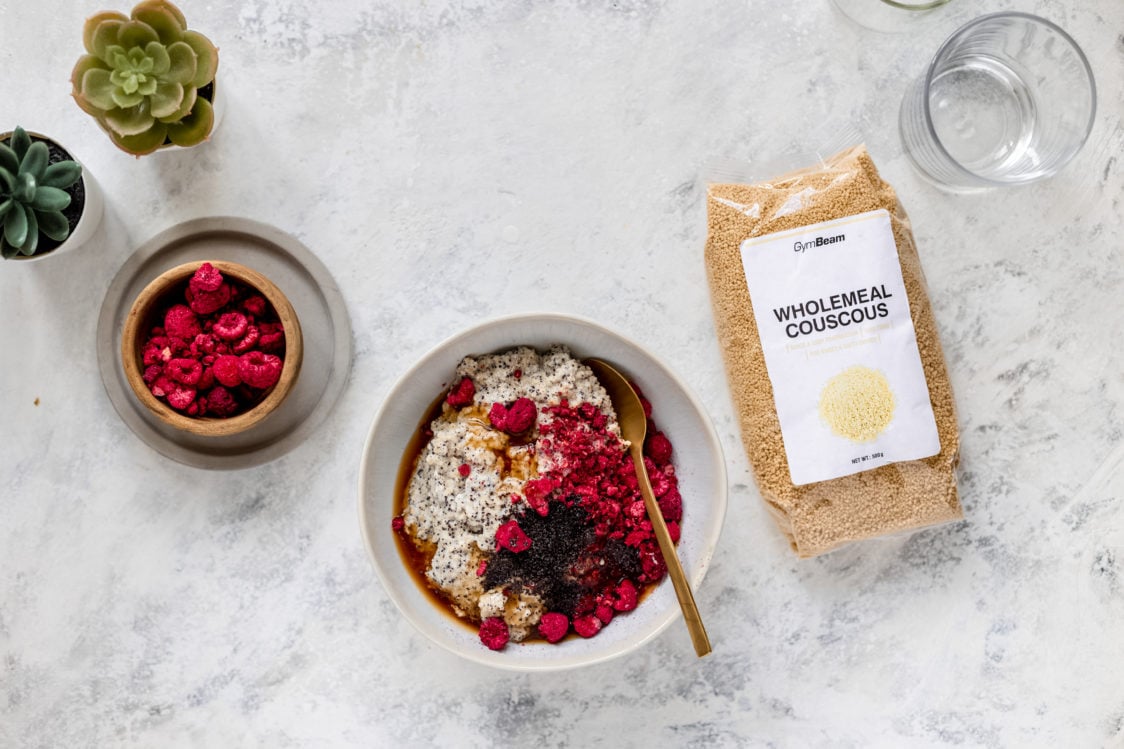
10. Legumes
Legumes are a versatile food that provides complex carbohydrates, protein, fibre and a wide range of micronutrients. In a way, these are often overlooked superfoods. Individual species differ slightly in terms of nutrient content, but the amount of carbohydrates is usually in the range of 30-50 g/100 g. What all legumes excel in is their fibre content. It is found in them in the amount of approximately 15-30 g / 100 g. For example, a 50 g serving of red lentils will easily provide you with 15 g of fibre, which is half the daily recommended amount.
What other nutrients do legumes contain?
Despite the fact that legumes are plant-based, they are considered a good source of protein. Although they are not as complete as animal sources (they do not contain the optimal amount of some essential amino acids), they are close to them. However, if you supplement them with cereal or meat, or other animal food, you have nothing to worry about, because the intake of essential amino acids will be more balanced.
How much energy and nutrients do legumes contain?
| Brown Lentils | Red Lentils | Chickpeas | Peas | Red Kidney Beans | Mungo Beans | |
|---|---|---|---|---|---|---|
| Energy Value | 319 kcal | 295 kcal | 366 kcal | 332 kcal | 314 kcal | 327 kcal |
| Carbohydrates | 40 g | 29 g | 51 g | 40 g | 46 g | 47 g |
| Protein | 26 g | 27 g | 21 g | 23 g | 22.5 g | 24 g |
| Fat | 1 g | 1 g | 6 g | 4 g | 1 g | 1.2 g |
| Fibre | 23 g | 31 g | 12 g | 22 g | 15 g | 16 g |
How to include legumes in your diet?
- Make a simple and tasty soup from them.
- Spice things up with an unusual legume spread.
- You can also just add them to a salad or prepare a meat-free meal where you replace the meat with legumes.
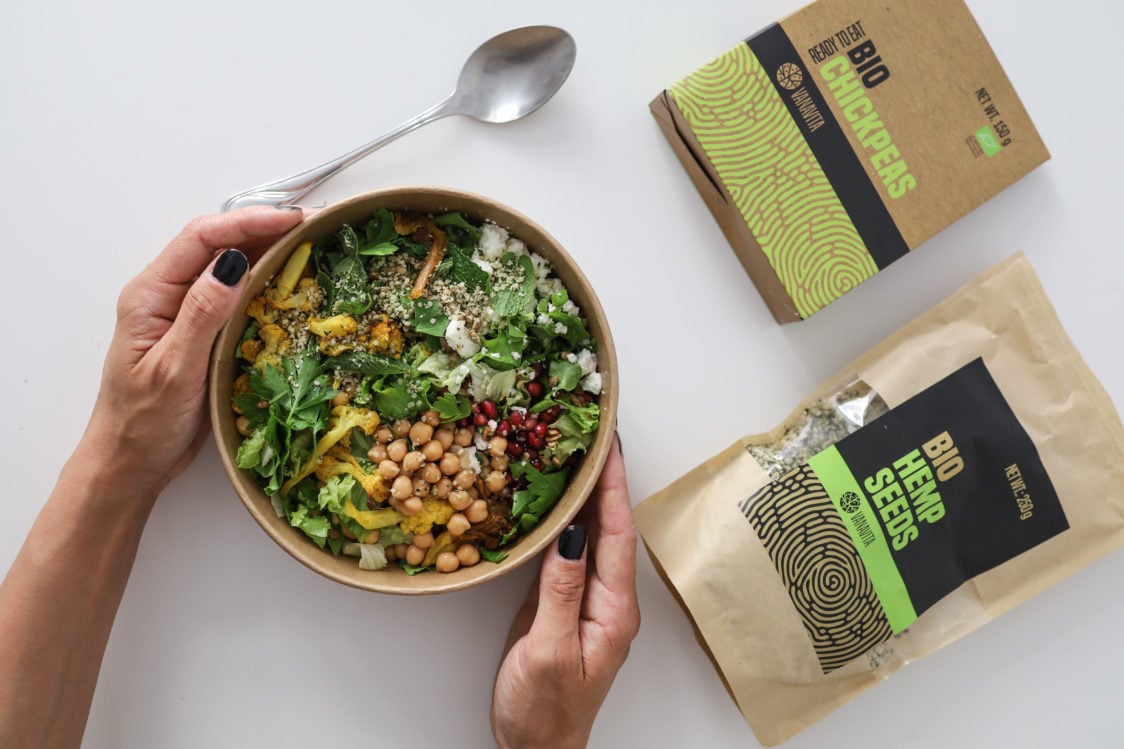
11. Muesli
The term muesli entails countless products. This group contains everything from a mixture of different types of flakes to baked muesli, the nutritional profile of which can sometimes be closer to some sweets. All products from this group are a source of complex carbohydrates, but many of them also contain a large amount of sugar and fat. This makes them a type of food that should not appear in your diet regularly.
However, if you choose well, muesli can be a regular and healthy part of your diet. With the right choice, it will be a great source not only of complex carbohydrates that satiate, but also a good source of fibre, vitamins and other nutrients.
How to choose the right muesli?
- First of all, always read the labels on food packages.
- Check the ingredients list of the chosen muesli. A good rule of thumb is “the shorter, the better”.
- Look for whole grains at the beginning of the ingredients list. These can be, for example, oats, buckwheat flour, wholemeal flour, etc. The higher the proportion of these ingredients, the better.
- Chose those that don’t contain added sugar. If you can’t do without sweetened muesli, choose at least those that don’t have it written at the top of the list.
- Also pay attention to the table of nutritional values. The goal should be a product with as little sugar as possible and with an amount of fibre of at least 5 g/100 g.
- You should probably avoid baked muesli as a whole. After reading the ingredients, you will find that they are in most cases full of added sugar and fat.
- The best option is muesli made from different types of flakes, or with added nuts or dried fruit.
How much energy and nutrients do muesli contain?
Basic Loose Muesli with Nuts | Basic Baked Muesli with Nuts | |
|---|---|---|
| Energy Value | 424 kcal / 1781 kJ | 448 kcal / 1882 kJ |
| Carbohydrates | 50 g | 57 g |
| of which sugars | 1 g | 16 g |
| Protein | 15 g | 9 g |
| Fat | 16 g | 19 g |
| Fibre | 10 g | 6.5 g |
How to include muesli in your diet?
- If you need a quick breakfast or snack, there is nothing easier than pouring muesli into yogurt and enjoying them together with some fruit and nuts or nut butter.
- You can replace yogurt with quark, skyr or sour drink, which gives you several other options of this simple dish.
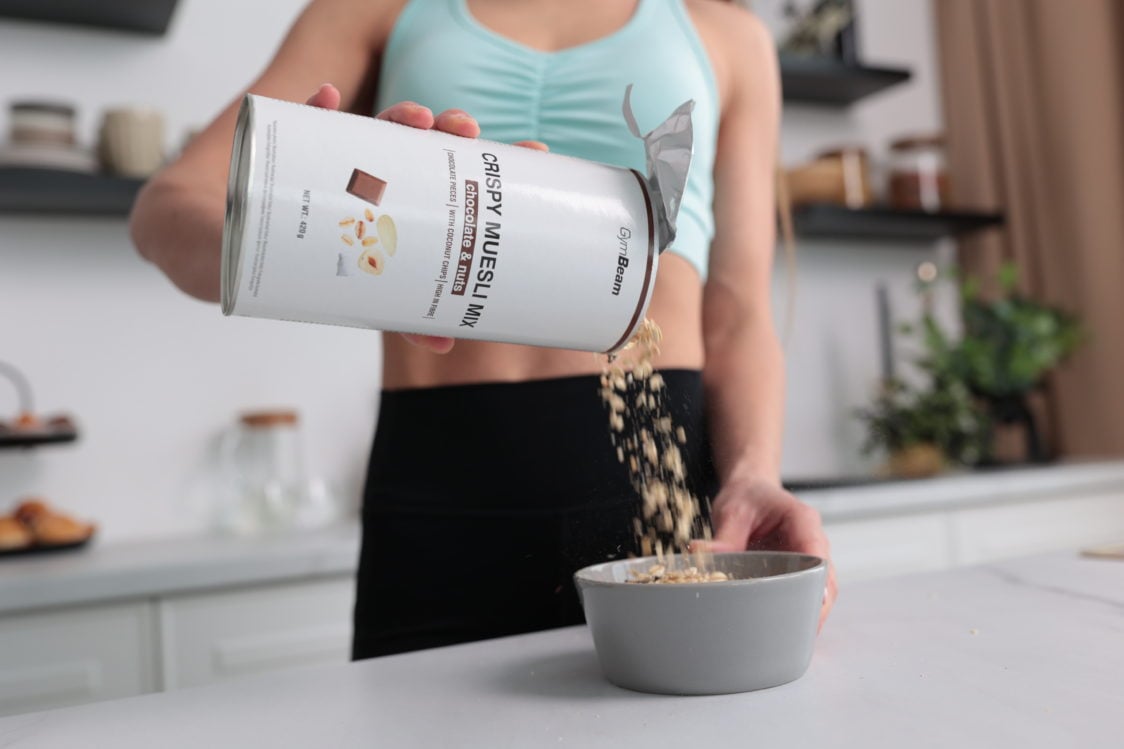
12. Fruit
Unlike the previous foods, fruit is mainly a source of simple carbs, while it contains only a minimal amount of polysaccharides. For example, 100 g of apple contains 12 g of carbohydrates, of which 11 g are sugars, which means that compared to whole grain pasta or legumes, it won’t satiate as well. At the same time, it is digested faster and can cause greater fluctuations in blood sugar (glycemia) compared to foods that are a source of complex carbohydrates.
However, this doesn’t mean that fruit does not belong in our diet. On the contrary, it has many health benefits, such as its fibre content, and many studies report that it is associated with, for example, lower body weight, lower energy intake, or a reduced risk of developing cardiovascular diseases. [2]
You shouldn’t indulge in unlimited amounts of fruit. Stick to the recommendations and eat roughly two portions a day (one portion fits into your handful), and you won’t have to worry about overdoing it with the amount of sugar. In addition, it is always better to treat yourself to natural sugar in fruit, because that way you’ll receive it in combination with fibre and other nutrients. [20]

What other nutrients does fruit contain?
Fruit lacks complex carbohydrates, proteins or fat, but it makes up for it with its content of minerals, vitamins and other bioactive compounds. Each fruit excels in the content of different nutrients, so it is ideal to have as many types as possible in your diet. Berries and kiwi are, for example, a good source of vitamin C. Bananas, apricots and peaches are rich in potassium. The fibre content in the fruit ranges roughly from 1-7 g / 100 g, while soluble and insoluble types of fibre are both present and combined. [2,17]
How much energy and nutrients do some fruits contain?
Apple | Banana | Orange | |
|---|---|---|---|
| Energy Value | 53 kcal / 223 kJ | 93 kcal / 390 kJ | 49 kcal / 206 kJ |
| Carbohydrates | 11.4 g | 20.2 g | 10 g |
| Protein | 0.26 g | 1 g | 0.9 g |
| Fat | 0.2 g | 0.3 g | 0.15 g |
| Fibre | 2.4 g | 2.6 g | 2 g |
How to include fruit in your diet?
- If you’re tired of crunching a raw apple for every snack, add it to porridge, yogurt, or try our recipe for battered apple rings.
- You can also use fruit to make some dessert such as this tasty strudel or banana bread.
- Fruit can also be turned into a healthier version of ice cream or you can add it to a smoothie.
You can read more interesting facts about fruit in the article Fruit:How Many Calories and What Vitamins and Minerals Does It Contain?
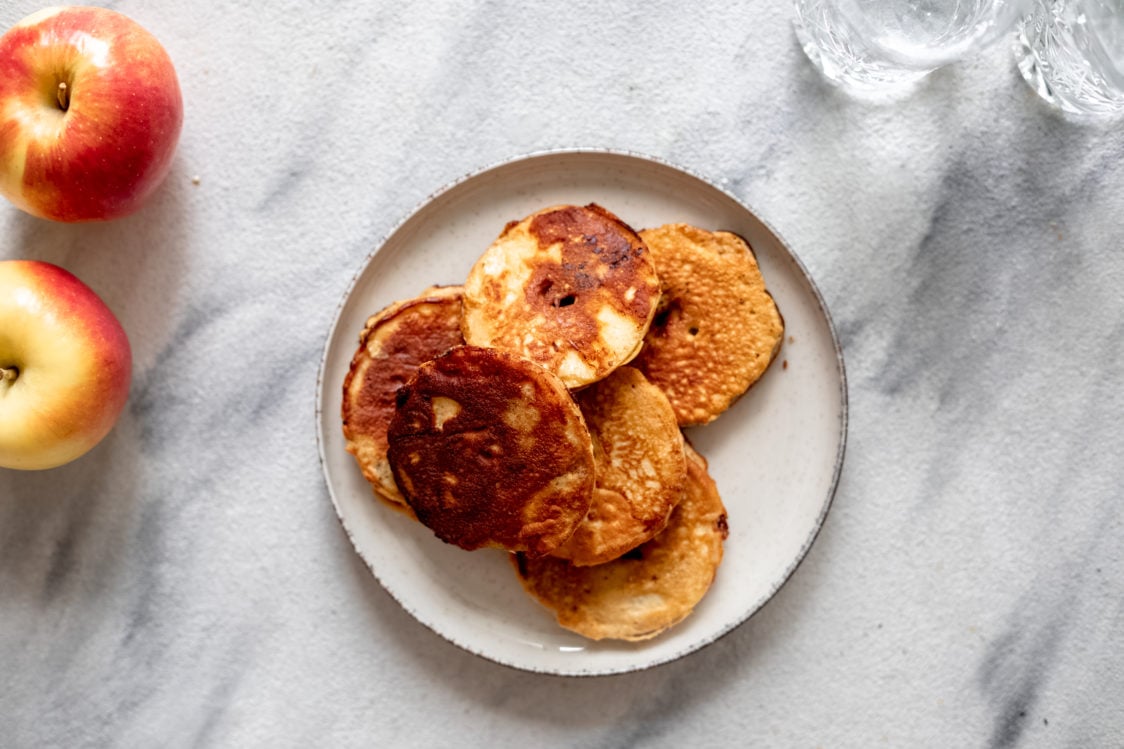
What to take from it?
Carbohydrates belong to every healthy diet. Our body needs them for its proper function. In addition, high-carb foods also contain a large number of other nutrients that are not present in other food groups. For example, you won’t find fibre in meat or other animal foods.
However, each high-carb food is different and therefore it is necessary to know how to make the right food choices. Fortunately, after reading this article, you have a clearer understanding of this topic and know which foods to reach for. So, which new foods will you try the next time you cook?
If you found this article helpful, don’t keep it to yourself and share it with your friends and family.
[1] ATKINSON, F.S. et al. International tables of glycemic index and glycemic load values 2021: a systematic review. – https://www.sciencedirect.com/science/article/pii/S0002916522004944
[2] DREHER, M.L. Whole Fruits and Fruit Fiber Emerging Health Effects. – https://www.ncbi.nlm.nih.gov/pmc/articles/PMC6315720/
[3] DUYFF, R.L. Complete Food & Nutrition Guide. . New York: Academy of Nutrition and Dietetics, 2017. ISBN 978-0-544-52058-5.
[4] EFSA PANEL ON DIETETIC PRODUCTS, NUTRITION, AND ALLERGIES (NDA) Scientific Opinion on Dietary Reference Values for carbohydrates and dietary fibre. – https://onlinelibrary.wiley.com/doi/abs/10.2903/j.efsa.2010.1462
[5] ENOGIERU, A.B. et al. Rutin as a Potent Antioxidant: Implications for Neurodegenerative Disorders. – https://www.ncbi.nlm.nih.gov/pmc/articles/PMC6040293/
[6] GIL, A. et al. Wholegrain cereals and bread: a duet of the Mediterranean diet for the prevention of chronic diseases. – https://pubmed.ncbi.nlm.nih.gov/22166190/
[7] HASSAN, Z.M. et al. The nutritional use of millet grain for food and feed: a review. – https://www.ncbi.nlm.nih.gov/pmc/articles/PMC8005370/
[8] KLOSE, C. - ARENDT, E.K. Proteins in oats; their synthesis and changes during germination: a review. – https://pubmed.ncbi.nlm.nih.gov/22530714/
[9] LI, L. et al. Buckwheat and CVD Risk Markers: A Systematic Review and Meta-Analysis. – https://www.ncbi.nlm.nih.gov/pmc/articles/PMC5986499/
[10] MOHANRAJ, R. - SIVASANKAR, S. Sweet potato (Ipomoea batatas – L.] Lam)--a valuable medicinal food: a review. [https://pubmed.ncbi.nlm.nih.gov/24921903/
[11] PAUDEL, D. et al. A Review of Health-Beneficial Properties of Oats. – https://www.ncbi.nlm.nih.gov/pmc/articles/PMC8625765/
[12] RAGUINDIN, P.F. et al. A systematic review of phytochemicals in oat and buckwheat. – https://www.sciencedirect.com/science/article/pii/S0308814620318446
[13] SATYAVATHI, C.T. et al. Pearl Millet: A Climate-Resilient Nutricereal for Mitigating Hidden Hunger and Provide Nutritional Security. – https://www.ncbi.nlm.nih.gov/pmc/articles/PMC8475763/
[14] SHEWRY, P.R. Tuber Storage Proteins. – https://www.ncbi.nlm.nih.gov/pmc/articles/PMC4242388/
[15] SINGH, R. et al. Avena sativa (Oat), a potential neutraceutical and therapeutic agent: an overview. – https://pubmed.ncbi.nlm.nih.gov/23072529/
[16] STERNA, V. et al. Oat Grain Composition and its Nutrition Benefice. – https://www.sciencedirect.com/science/article/pii/S2210784316301000
[17] USDA FoodData Central. – https://ndb.nal.usda.gov/index.html
[18] VEGA-GÁLVEZ, A. et al. Nutrition facts and functional potential of quinoa (Chenopodium quinoa willd.), an ancient Andean grain: a review. – https://pubmed.ncbi.nlm.nih.gov/20814881/
[19] Food and Feed Information Portal Database | FIP. – https://ec.europa.eu/food/food-feed-portal/screen/health-claims/eu-register
[20] Hand Portion FAQ: A Guide from Precision Nutrition. – https://www.precisionnutrition.com/hand-portion-faq
[21] Sweet potato, raw, unprepared.– https://nutritiondata.self.com/facts/vegetables-and-vegetable-products/2666/2
[22] Coeliac disease on the rise in Europe. – https://www.eufic.org/en/healthy-living/article/coeliac-disease-on-the-rise-in-europe

